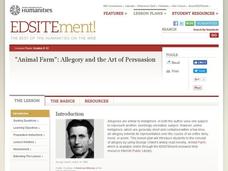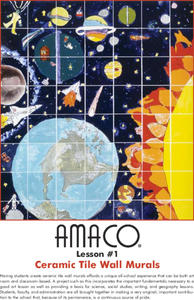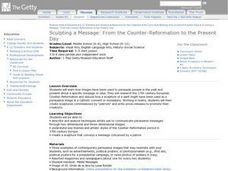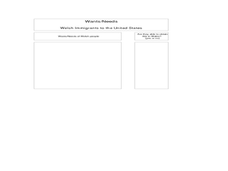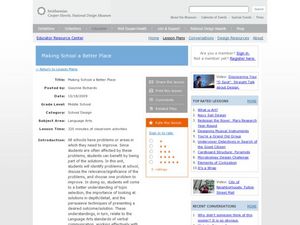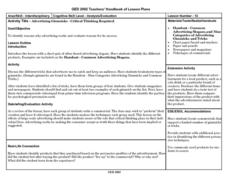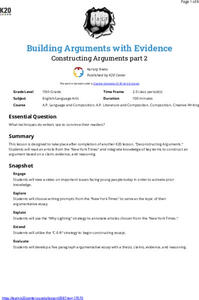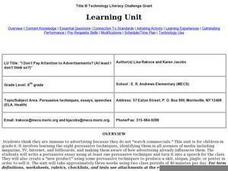National Endowment for the Humanities
Animal Farm: Allegory and the Art of Persuasion
Introduce your class members to allegory and propaganda with a series of activities designed to accompany a study of George Orwell's Animal Farm. Readers examine the text as an allegory, consider the parallels to collective farms and the...
Channel Islands Film
Magic Isle: Lesson Plan 1
What are the factors that limit growth and expansion? As part of their study of Catalina Island, class members view the West of the West's documentary Magic Isle and research William Wrigley and the Santa Catalina Island Company. After...
Curated OER
"The Merchants of Cool"
Why are so many advertisements geared towards the teenage population? Watch a video with your class (link included), and have them fill out the attached listening guide. Then discuss persuasion, presenting biased information, and where...
Curated OER
Author's Day
Have your learners choose an author to study. One resource link gives a list of approved authors. Scholars read at least three works produced by that author and produce three separate book reports as well as a two-page author report....
American Art Clay Co., Inc.
Ceramic Tile Wall Murals
Science, social studies, language arts, and art classes work together with administrators to produce a permanent, ceramic tile wall mural to install at their school.
Curated OER
See How They Run
High schoolers analyze non-print campaign advertisements for factual and persuasive information. They choose the advertisement they think is the most persuasive and identify the reasons why it is the most persuasive.
Curated OER
Defending Great Literature
Students defend Mark Twain and the study of The Adventures of Huckleberry Finn using persuasive techniques, appropriate word choice, and correct letter format, in response to a fictional letter by an upset parent.
Curated OER
Sculpting a Message: From the Counter-Reformation to the Present Day
Students discuss persuasive messages in art. In this art history lesson, students research 17th- century European sculptures to find the messages given. They create their own sculptures and write press releases to explain their art.
Curated OER
Unit Plan for Mark Twain and American Humor
Students create brochures about the humor of Mark Twain. In this literature-analysis lesson plan, students read "The Celebrated Jumping Frog of Calaveras County" and other short stories by Twain. Students write analytical paragraphs and...
Curated OER
Thomas Jefferson's Library: Making the Case for a National Library
Young scholars examine a letter written by Thomas Jefferson. In this lesson on the Thomas Jefferson Library, students discover a methodology for creative writing by examining Jefferson's letter to congress explaining why they should...
Curated OER
Poet Naomi Shihab Nye
Students read and analyze poetry by Naomi Shihab Nye. They define stereotypes, view and discuss a video interview with Nye, present an oral reading of a poem, and write a persuasive letter to an author.
Curated OER
Getting our Paws into the Cause
Twelfth graders examine local, state, and/or national animal welfare organization. In this Social Studies lesson, 12th graders research their identified organization. Students develop a planned intervention strategy to help persuade...
Curated OER
Push/Pull Factors and Welsh Emigration
Students view and discuss short sections of movies that relate to immigration. Working in groups, students create a map that shows directions of internal migration in their assigned geographical area. Students review ads/booklets created...
Curated OER
The Power of Persuasion
Young scholars explore the power of persuasion. In a classroom setting, students discuss incentives, testimonials and deceptive pricing schemes that are used to influence others. After observing professionally made infomercials, young...
Curated OER
A Picture is Worth a Thousand Words: Public Views of Lincoln
Students write a letter in the voice of Abraham Lincoln. In this history lesson, students interpret the way the public viewed Lincoln during various times by examining political cartoons and images. Students write a letter in the voice...
Curated OER
Deception and Advertising: When is it Misleading and when is it Puffery?
Eighth graders explore advertisements and deception in advertising. In this marketing and advertising lesson, 8th graders write cause and effect paragraphs describing products, promises made, deceptions caused, and the immediate and...
Curated OER
Making School a Better Place.
Students study the problems in their school and work on solutions for those problems. In this writing process lesson, students analyze a problem and work as a team to find a solution. Students present written and oral work to support...
Curated OER
Advertising Gimmicks - Critical Thinking Required
Students identify reasons why advertising works, evaluate reasons for its success, and write commercials.
National Endowment for the Humanities
A Defense of the Electoral College
Each presidential election year, the debate about the electoral college rages. Michael C. Maibach's "A Defense of the Electoral College" offers young political scientists an opportunity to examine a reasoned argument for why the...
K20 LEARN
Building Arguments With Evidence: Constructing Arguments Part 2
The second session in the two-part "Building Arguments with Evidence" lesson asks scholars to craft an argument essay on a topic of interest to them. Writers establish a claim, locate evidence, and justify their stance.
Orlando Shakes
Arms and the Man: Study Guide
Few aspects of life make better fodder for a comedic play than politics. A study guide introduces George Bernard's Shaw comedy Arms and the Man. Along with summaries of each scene and brief biographies of the main characters, two lesson...
Curated OER
Language Arts: The Three Appeals
High schoolers are able to identify and describe the persuasive techniques used in editorial writing. They are able to label persuasive techniques with the logos, pathos, and ethos terminology.
Curated OER
I Don't Pay Attention to Advertisements
Sixth graders examine the eight persuasive techniques, identifying them in all avenues of media including magazine, TV, Internet, and billboards, and making them aware of how advertising already influences them. They write an essay using...
Curated OER
What's My Point?
Sixth graders move through the process of defining persuasion, identifying persuasive arguments and techniques in writing and evaluating their own use of accurate details. Students also define an author's point of view.


